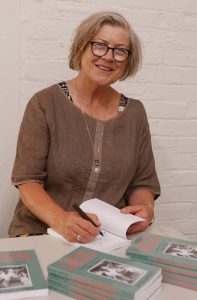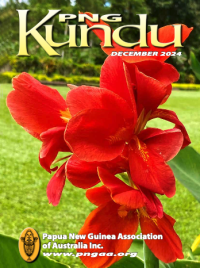Planting Memories:A Settler’s Life on the Sogeri Plateau
Anthea Matley
At the beginning of September 2018, long after my parents had passed away, I said to my husband, Peter: ‘I want to go back to New Guinea. Do you think we can do it? Will you help me?’ He readily agreed, and a couple of weeks later we were on a flight to Port Moresby. We had no plan other than booking a room at the Grand Papua Hotel. We’d agreed to see how things were when we landed and allowed ourselves five days for the trip.
I popped the pressure in my ears as the plane descended to Jackson Airport, Port Moresby. A modern-looking airport terminal had replaced the tin shed I remembered from five decades earlier. Jackson Airport is at 7 Mile, 11 kilometres from the city. We were the only white people among the passengers who, I assumed, were either travelling home from shopping or working in Brisbane. Everyone was in a good mood with lots of laughter and chatter and although we exchanged smiles with several of our fellow passengers, we didn’t have a chance to speak to them on the short flight.
After disembarking and reaching border control, I handed over my documents to the serious-looking young woman with her long black hair pulled tightly into a neat bun on top of her head. She wore a pale blue, open-necked shirt with a colourful emblem on the sleeve and a matching dark blue skirt.
‘What is the purpose of your visit?’ she asked, taking my passport and papers and closely studying my identification details. ‘It says here you were born in Port Moresby.’ She looked up at me, her eyes widening.
‘Yes! I was born here. I’ve come back for a visit,’ I replied with a smile.
She laughed, shaking her head: ‘You were born here! Welcome home.’ She lifted her arm high, stamped our visas with a flourish and waved us through, still smiling. I nearly cried at the warmth of her welcome and felt I had made the right decision to embark on this sentimental journey.
We moved outside the airport to the pick-up area. The hotel had promised to send a car to meet us. As soon as we stepped out of the airconditioned building we started to perspire. The air was hot and humid, with a blustery wind raising dust and rubbish into little eddies in the corners of the buildings. It seemed to change direction continually, and we couldn’t find any shelter. Our shirts clung to our bodies, and grit stuck to our sweaty faces. September is a warm, dry month in Papua but still humid. A shower and change from travelling clothes were a priority.
The airport was quiet. Below the ‘Welcome to Papua New Guinea’ sign was a large warning, ‘No betel nut chewing. No smoking’. Our fellow passengers quickly disappeared out the front doors to waiting vehicles or to continue their journeys on foot. Soon, we were the only ones waiting. After an hour, we phoned the hotel and eventually a large van arrived to collect us. We were the only passengers.
The slow drive through the city’s outskirts gave us plenty of time to take in the suburbs bustling with people, mainly men. Most had beards and either squatted or stood in small groups outside graffitied buildings. Dressed in shorts and tee-shirts with fading slogans they spat, smoked and argued. According to our driver, the piles of rubbish littering the sides of the road were due to an ongoing garbage strike. In contrast, the central city area looked like any modern city with high-rise buildings and lots of traffic (both vehicular and foot) as people went about their business.
The driver explained it was a month before the Asia-Pacific Economic Cooperation (APEC) forum, and the PNG government wanted the city cleaned up before the international visitors arrived. Betel nut chewing, popular and rampant throughout the country, was banned. When mixed in the mouth with mustard and lime, the chewed betel nut produces a red liquid. When it’s spat onto the concrete pavements and curbs, removing the stains is very difficult.
At the Grand Papua Hotel, we asked a young man at the reception if he could arrange a four-wheel-drive vehicle and driver to take us into the mountains. He looked inexperienced and flustered, so he called another young man over who asked us what we wanted. He too looked unsure and called a third person, a young woman, who was more fluent in English. They either didn’t understand what we were asking for or genuinely couldn’t help, because they were vague in their answers, looking at each other and shaking their heads. We decided not to pursue it and went to our room.
With some effort, we got onto the internet and tracked down an Australian-run security firm. The process took most of our first day before we found the necessary vehicle and driver. The difficulty was specifically requesting a four-wheel-drive vehicle. City cars were plentiful but not what we needed. My brother had walked the Kokoda Track a few years before and had tried to visit the plantation we grew up on but was unable to due to the road’s poor condition. He said we would need a four-wheel-drive vehicle to tackle it. We finally arranged a vehicle and driver to take us inland in three days’ time. The next morning we thought we would do some sightseeing.
‘Is it safe to walk the streets?’ I asked the desk staff. ‘Oh yes. Safe,’ they said, nodding.
We headed down to Ela Beach, about 400 metres from the hotel. I had great memories of family picnics here under the shade of coconut trees, playing in the sand and paddling in the warm ocean, the laughter and shrieks as a thronging mixture of European and local people picnicked and swam together. We crossed a busy four-lane highway, and we had to use the pedestrian crossing button to cross the road.
From the highway, we could see the beach. It was a sad sight. All the trees and vegetation had been removed and it looked denuded and lifeless, with yellow plastic barriers roping off the sand. There wasn’t a soul on the beach, or in the water. A fancy new Conference Centre had been built on the foreshore in anticipation of the expected foreign visitors and the government didn’t want anyone messing up the beach.
We continued our walk along the footpath, following the shoreline in search of a café we’d read in a hotel brochure that was worth visiting. The hot wind blew relentlessly. The occasional vehicle making its way down Bramell Street slowed down, the occupants staring at us—probably wondering why on earth we would choose to walk around in this uncomfortable heat and wind.
We approached the busy waterfront, which hugs the south side of the harbour and where lots of road construction was in progress. We walked and walked but couldn’t find the café. Eventually, we passed the busy port and headed into a deserted area. We stopped to look at the map, and a police car pulled up. The officer was a policewoman from New Zealand, sent to help with law and order during the APEC summit.
‘Can I help you two?’ she asked. ‘I saw you were looking a bit lost, and you don’t want to do that here; it’s too dangerous. Hop in, and I’ll take you where you want to go.’
This is an extract from the chapter ‘Port Moresby, 2018’, from Anthea’s new book, Planting Memories—A Settler’s Life on the Sogeri Plateau, which was reviewed by Keith Stebbins in the June 2024 issue of PNG Kundu. The second part of the chapter will be published in the next issue.



